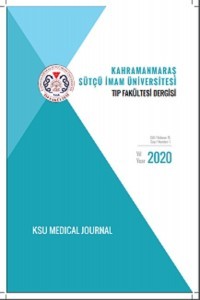Çocuk Kardiyoloji Polikliniğine Akut Göğüs Ağrısı Nedeniyle Başvuran Çocukların Etiyolojik Açıdan Değerlendirilmesi
Antifungal ilaç direnci, Candida albicans, Triazol, Vücut sıvısı
Etiological Evaluation of Children Admitted to the Pediatric Cardiology Outpatient Clinic, with Acute Chest Pain
Antifungal drug resistance, Body fluid, Candida albicans, Triazole,
___
- Costa-de-Oliveira S, Rodrigues AG. Candida albicans antifungal resistance and tolerance in bloodstream infections: The triad yeast- host-antifungal. Microorganisms 2020;154(8):1-19.
- Cheng MF, Yang YL, Yao TJ, Lin CY, Liu JS, Tang RB et al. Risk factors for fatal candidemia caused by Candida albicans and non-albicans Candida species. BMC Infectious Diseases 2005;5:22.
- Erdem I, Ozgultekin A, Inan AS, Engin DO, Akcay SS, Turan G et al. Bloodstream infections in a medical-surgical intensive care unit: Incidence, aetiology, antimicrobial resistance patterns of gram-positive and gram-negative bacteria. Clin Microbiol Infect 2009;15(10):943-946.
- Pappas PG, Kauffman CA, Andes D, Clancy CJ, Marr KA, Ostrosky- Zeichner L et al. Clinical practice guidelines for the management of candidiasis:2016 update by the Infectious Diseases Society of America. Clin Infect Dis 2015;62(4):1-50.
- Hitkova HY, Georgieva DS, Hristova PM and Sredkova MP. Antifungal susceptibility of Candida albicans isolates at a tertiary care hospital in Bulgaria. Jundishapur J Microbiol 2019. In Press (In Press):e92079.
- Pristov KE, Ghannoum MA. Resistance of Candida to azoles and echinocandins worldwide. Clinical Microbiology and Infection 2019;25:792-798.
- Mukherjee PK, Chandra J, Kuhn DM, Ghannoum MA. Mechanism of fluconazole resistance in Candida albicans biofilms: Phase-specific role of efflux pumps and membrane sterols. Infect Immun 2003;71:4333–4340.
- Ramage G, Rajendran R, Sherry L, WilliamsC. Fungal biofilm resistance. Int J Microbiol 2012:528521.
- Ramage G, Bachmann S, Patterson TF, Wickes BL, Lopez-RibotJL. Investigation of multidrug effluxpumps in relation to fluconazole resistance in Candida albicans biofilms. J Antimicrob Chemother. 2002;49:973–980.
- Kanafani ZA, Perfect JR. Antimicrobial resistance: Resistance to antifungal agents: mechanisms andclinical impact. Clin Infect Dis 2008;46:120–128.
- Pappas, PG, Lionakis, MS, Arendrup MC, Ostrosky-Zeichner L, Kullberg BJ. Invasive candidiasis. Nat Rev Dis Primers 2018; 4:18026.
- Hospenthal DR, Murray CK, Rinaldi MG. The role of antifungal susceptibility testing in the therapy of candidiasis. Diagn Microbiol Infect Dis. 2004;48,153–160.
- Alastruey-Izquıerdo A, Melhem MSC, Bonfıettı LX, Rodrıguez- Tudela JL Susceptibility test for fungi: Clinical and laboratorial correlations in medical mycology. Rev Inst Med Trop Sao Paulo 2015;57(19):57-64.
- Orasch C, Marchetti O, Garbino J, Schrenzel J, Zimmerli S, Mühlethaler K et al. Candida species distribution and antifungal susceptibility testing according to European Committee on Antimicrobial Susceptibility Testing and new vs. old Clinical and Laboratory Standards Institute clinical breakpoints: A 6-year prospective candidaemia survey from the fungal infection network of Switzerland. Clin Microbiol Infect 2014;20:698–705.
- Lindberg E, Hammarström H, Ataollahy, Kondori N. Species distribution and antifungal drug susceptibilities of yeasts isolated from the blood samples of patients with candidemia. Scientific Reports 2019;9:3838.
- Dalyan Cilo B, Topaç T, Ağca H, Sağlam S, Efe K, Ener B. Comparison of Clinical Laboratory Standards Institute (CLSI) and European Committee on Antimicrobial Susceptibility Testing (EUCAST) broth microdilution methods for determining the susceptibilities of Candida isolates. Bulletin of Microbiology 2018;52 (1):35-48.
- Gülat S, Doluca Dereli M. Investigation of the expression levels of efflux pumps in fluconazole-resistant Candida albicans isolates. Bulletin of Microbiology 2014;48(2):325-334.
- Coşkun Ö, Beşirbellioğlu B, Yıldıran ŞT, Gönlüm A, Pahsa A. In-vitro susceptibilities of Candida species isolated from candidemic patients against amphotericin B and fluconazole. Bulletin of Microbiology 2001;35:565-571.
- Hope W W, Billaud EM, Lestner J, Denning DW. Therapeutic drug monitoring for triazoles. Curr Opin Infect Dis 2008; 21:580-586.
- ISSN: 1303-6610
- Yayın Aralığı: Yılda 3 Sayı
- Başlangıç: 2004
- Yayıncı: Kahramanmaraş Sütçü İmam Üniversitesi
Kikuchi-Fujimoto Hastalığı mı, Lenfoma mı?
Sema YILDIRIM, Ayşe AŞIK, Bengü ÇOBANOĞLU ŞİMŞEK, Ayşe BOZKURT
Büşra SEĞMEN, Sadık YURTTUTAN, Nurten SERİNGEÇ AKKEÇECİ, Fatma İNANÇ TOLUN, Aydın BOZKAYA
Serum 25-Hidroksi Vitamin D Düzeyi Siğil Şiddetini Yansıtmaz: Kesitsel Bir Çalışma
Gökşen ERTUĞRUL, Habibullah AKTAŞ
Alirıza ERDOĞAN, Selim ÇINAROĞLU
İbrahim YILDIZ, Erdogan MALATYALİ
112 Ambulans Çalışanlarının Hizmet ve Sosyal Durumlarının Değerlendirilmesi
Muhammed Semih GEDİK, Hakan HAKKOYMAZ, Nuri Mehmet BASAN, Yılmaz SAFİ, Erdem AKSAY
Geç Tanı Klasik Fenilketonüri Olgularımız ve Geç Tanı Nedenleri
Nafiye Emel ÇAKAR, Pınar YILMAZBAŞ
Prostat Kanseri Kemik Metastazına Radyoterapi Uygulanan Hastalarda Sağ Kalımı Etkileyen Faktörler
